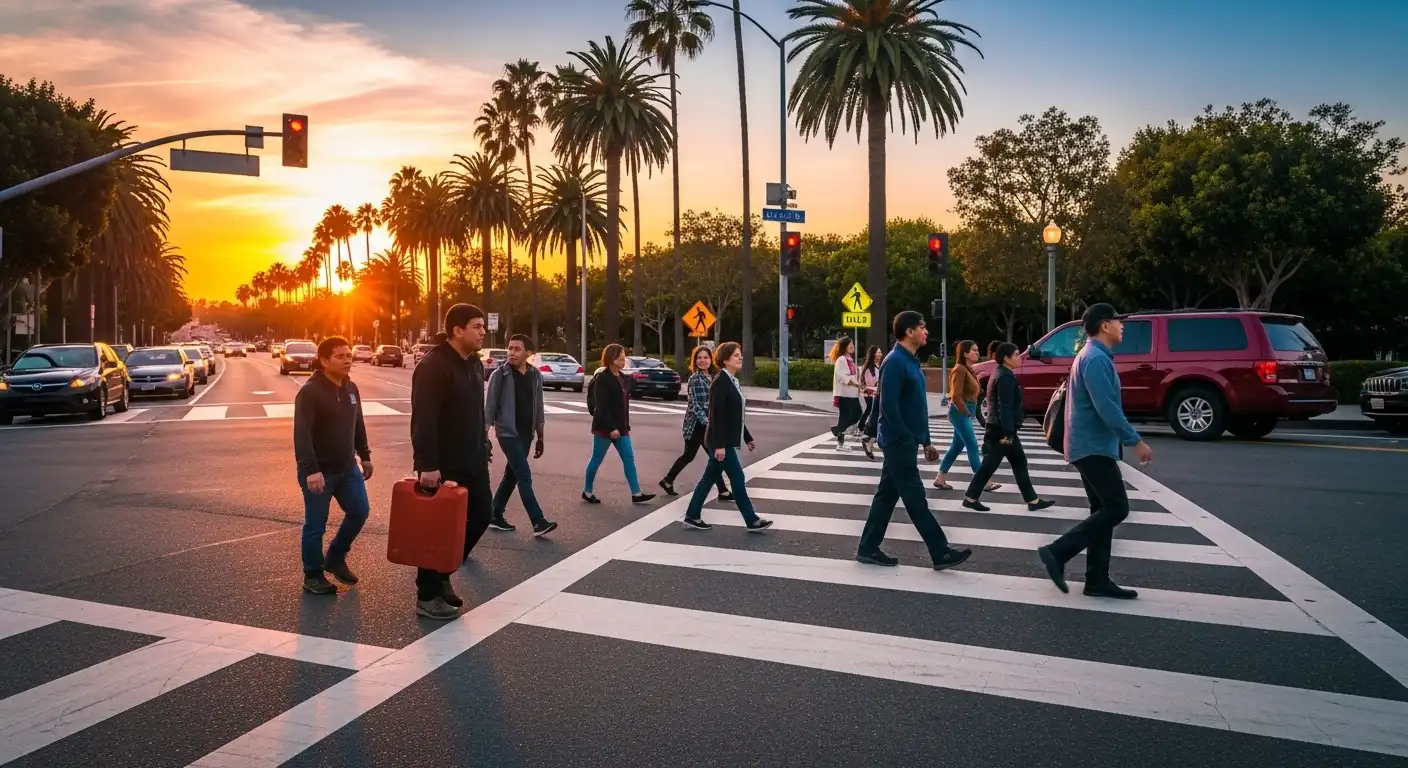Pedestrian accidents are a serious concern in California, a state with bustling cities, heavy traffic, and a wide variety of pedestrian environments. While California is known for its beautiful weather, perfect for walking, biking, and other outdoor activities, it also faces a growing number of pedestrian accidents that raise important questions about safety.
In this blog, we’ll delve into California pedestrian accident statistics, providing insight into the number of incidents, common causes, and trends over recent years. By understanding these statistics, we can work toward improving pedestrian safety on California roads.
1. California Pedestrian Accident Trends: An Overview
California consistently ranks as one of the top states in the U.S. for pedestrian accidents. According to the California Office of Traffic Safety (OTS), pedestrian fatalities have been on the rise in recent years. In fact, in 2020, pedestrian fatalities in California accounted for more than 25% of all traffic-related deaths in the state, a concerning trend for a state that prides itself on public health and safety.
Here’s a quick look at the pedestrian accident statistics in California:
-
Total pedestrian fatalities: In 2020, California recorded over 1,000 pedestrian fatalities.
-
Injuries: Thousands of pedestrians are injured each year, with more than 14,000 reported pedestrian injuries in 2020 alone.
-
Urban vs. Rural Accidents: The majority of pedestrian accidents happen in urban areas, with high-density cities like Los Angeles, San Francisco, and San Diego seeing the highest rates of incidents.
These numbers highlight the need for better pedestrian safety measures, particularly in highly populated areas.
2. The Most Dangerous Cities for Pedestrians
Certain cities in California are more prone to pedestrian accidents due to factors such as population density, road conditions, and traffic patterns. According to the National Highway Traffic Safety Administration (NHTSA), cities with high traffic congestion and frequent pedestrian activity tend to have higher accident rates.
Some of the most dangerous cities for pedestrians in California include:
-
Los Angeles: As the largest city in California, Los Angeles experiences a significant number of pedestrian accidents. In 2020, the city accounted for a large portion of California’s pedestrian fatalities, making it a focal point for safety improvements.
-
San Francisco: Known for its dense population and heavy pedestrian traffic, San Francisco is another city where pedestrian accidents are a frequent occurrence.
-
San Diego: With its popularity as a tourist destination and major metropolitan area, San Diego also sees a high rate of pedestrian accidents.
These cities, along with others across the state, are actively working to implement pedestrian safety measures, such as enhanced crosswalks, speed limits, and more effective law enforcement.
3. Contributing Factors to Pedestrian Accidents in California
Several key factors contribute to the high rate of pedestrian accidents in California. Understanding these causes can help identify ways to reduce accidents and increase pedestrian safety across the state.
-
Distracted Driving: Distracted driving remains one of the leading causes of pedestrian accidents. With more drivers using mobile phones and other distractions, the chances of a pedestrian being hit are significantly higher.
-
Impaired Driving: Driving under the influence of alcohol or drugs is another major factor contributing to pedestrian accidents in California. In 2020, impaired driving was involved in nearly 30% of pedestrian fatalities.
-
Speeding: Speeding vehicles, especially in areas with high pedestrian traffic, increase the likelihood of fatal accidents. Pedestrians struck by speeding vehicles are more likely to suffer serious injuries or die from the impact.
-
Failure to Yield: Many pedestrian accidents occur when drivers fail to yield at crosswalks or run red lights. This type of negligence leads to severe injuries for pedestrians, as they may not have time to react.
These factors highlight the importance of education, awareness campaigns, and stricter traffic enforcement to reduce the number of pedestrian accidents in California.
4. Pedestrian Accidents by Time and Location
Time of day and location also play a significant role in pedestrian accidents. Understanding these patterns can help both pedestrians and drivers be more cautious during high-risk periods.
-
Time of Day: Pedestrian accidents are most likely to occur at night. According to statistics, over 70% of pedestrian fatalities happen after dark, when visibility is reduced, and drivers may not see pedestrians in time to avoid accidents.
-
Roadway Type: Intersections, busy streets, and highways are the most common locations for pedestrian accidents. Pedestrians are often struck while crossing busy roads or while walking on roads without proper sidewalks or pedestrian infrastructure.
Cities like Los Angeles and San Francisco are actively working on improving nighttime visibility with better street lighting and pedestrian-friendly infrastructure.
5. Pedestrian Safety Initiatives in California
In response to the growing number of pedestrian accidents, California has implemented several initiatives aimed at improving pedestrian safety. These efforts focus on both preventative measures and legislative changes:
-
Vision Zero: California cities like Los Angeles and San Francisco have adopted the Vision Zero initiative, a global movement aimed at eliminating traffic-related deaths and injuries. This initiative focuses on improving road infrastructure, enforcing traffic laws, and educating the public about pedestrian safety.
-
Improved Infrastructure: Cities are investing in safer crosswalks, pedestrian bridges, and designated lanes for walking to reduce accidents. The addition of more traffic signals and pedestrian-friendly zones can significantly reduce the risk of collisions.
-
Pedestrian Safety Laws: California has enacted various laws to protect pedestrians, such as laws requiring drivers to yield to pedestrians in crosswalks and restrictions on using mobile phones while driving.
These safety initiatives are designed to make California’s streets safer for pedestrians and reduce the number of accidents and fatalities.
6. What You Can Do to Stay Safe as a Pedestrian
While California is working to improve pedestrian safety, pedestrians can also take steps to protect themselves on the road. Here are some important safety tips:
-
Use Crosswalks: Always cross streets at designated crosswalks and pedestrian signals. Avoid jaywalking, as it increases your risk of being hit.
-
Be Visible: Wear bright or reflective clothing when walking at night. Carrying a flashlight or using reflective accessories can also help you stay visible to drivers.
-
Stay Alert: Avoid distractions like texting or wearing headphones while walking. Stay aware of your surroundings and watch for traffic signals.
-
Follow Traffic Signals: Wait for the walk signal before crossing, and be sure that all vehicles have stopped before stepping onto the road.
By following these tips, pedestrians can reduce their risk of accidents and stay safe while walking in California.
Conclusion: Moving Toward Safer Streets for Pedestrians
The pedestrian accident statistics in California reflect the ongoing challenges of keeping pedestrians safe on busy roads. However, through ongoing efforts to improve infrastructure, educate the public, and implement stricter laws, California is working to reduce pedestrian fatalities and injuries.
As pedestrians, we must remain vigilant and follow safety guidelines to protect ourselves, while drivers and lawmakers must continue to focus on making California’s streets safer for everyone.



